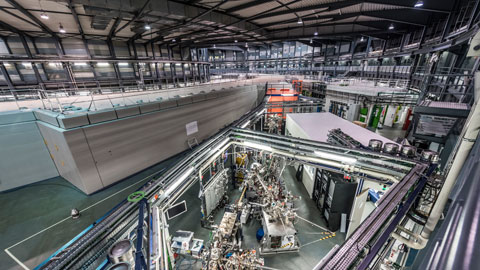
The ALBA Synchrotron will host two new major experimental facilities, one dedicated to materials science and another meant for molecular biology. The platform counts with the participation of the ICN2, IBMB-CSIC, BIST, CSIC, IRB Barcelona, UAB, ICMAB-CSIC and CRG, and it is co-financed through the ERDF.
Today it has been announced the provisional resolution of the last call for co-funding through the European Regional Development Fund (ERDF) of cooperative projects oriented at creating, building, acquiring and improving shared scientific and technological equipment and platforms. Among the approved strategic projects are two proposals, one led by the Catalan Institute of Nanoscience and Nanotechnology (ICN2) and the other by the Institute of Molecular Biology of Barcelona (IBMB-CSIC), which, thanks to the joint effort of nine research entities, will allow the installation of advanced electron microscopy equipment at the ALBA Synchrotron. This will make Barcelona a hub of excellence in Europe for scientific collaboration in this field.
The ERDF funds, granted by the Secretariat of University and Research of the Department of Business and Knowledge of the Generalitat of Catalonia (Catalan government), aims to provide the scientific community with equipment and platforms that enhance scientific and technological excellence, in particular those related to the transversal key enabling technologies included in the Research and Innovation Strategy for the Smart Specialisation of Catalonia (RIS3CAT). The contribution from European funds reaches up to 50 % of the total cost of their implementation.
The proposal led by the ICN2, which will cost approximately 4.1 million euros, is focused on acquiring and installing advanced equipment for electron microscopy and sample preparation especially designed for materials science and atomic-scale studies. This new installation consists of a Monochromated Transmission Electron Microscope with Aberration Correctors, which will be installed at the ALBA Synchrotron premises, and Focused Ion Beam (FIB) instrumentation to cut the samples in very thin layers and study them with atomic resolution, which will be installed at the ICN2. The realization of this project will be possible thanks not only to the ERDF grants, the "Severo Ochoa Centers of Excellence" ICN2 funds (SEV-2017-0706) and the ALBA Synchrotron investment, but also to the support of the CSIC, the Institute of Materials Science of Barcelona (ICMAB-CSIC) and the Autonomous University of Barcelona (UAB), as well as private donations from the Barcelona Institute of Science and Technology (BIST) —which is formed by institutions such as the ICN2, the CRG and the IRB Barcelona, and which in 2016 promoted the collaborations that have made this new platform possible— and Microsoft. The ICN2 and Microsoft are currently collaborating on the design of hybrid nanowire-based networks and circuits for quantum computers.
On the other hand, the project led by the IBMB-CSIC, valued at about 1.7 million euros, has the purpose of purchasing a high-voltage cryo-electron microscope for biological applications. This type of equipment allows observing the structure of biomolecules at atomic scale without the need to obtain crystals. It is a microscope suitable for biological sample screening and atomic-level structural data acquisition of large molecular and cellular complexes, e.g.: the external structure of a coronavirus as the one responsible for today's pandemics COVID-19 or the receptors these viruses use to get into the cells. This acquisition will be possible thanks to the funding from ERDF, the IBMB-CSIC and the ALBA Synchrotron, as well as to the contributions of the Institute for Biomedical Research (IRB Barcelona), the CSIC, the Centre for Genomic Regulation (CRG), the UAB and the BIST.
This cross-cutting initiative perfectly aligns with the worldwide trend of centralizing this kind of equipment near large particle accelerators or synchrotron facilities, with the uniqueness that this new research space will be created inside the ALBA premises. It will be a laboratory complementary to synchrotron-light ALBA beamlines, which will bring great added value for materials science and structural biology. The construction works to accommodate the new equipment are planned to start before the end of the year and it is expected that in about two years the new space will be able to receive the first users and host a constantly updated equipment. The electron microscopy platform will provide new opportunities to both research groups and companies looking for state-of-the-art microscopy equipment.






